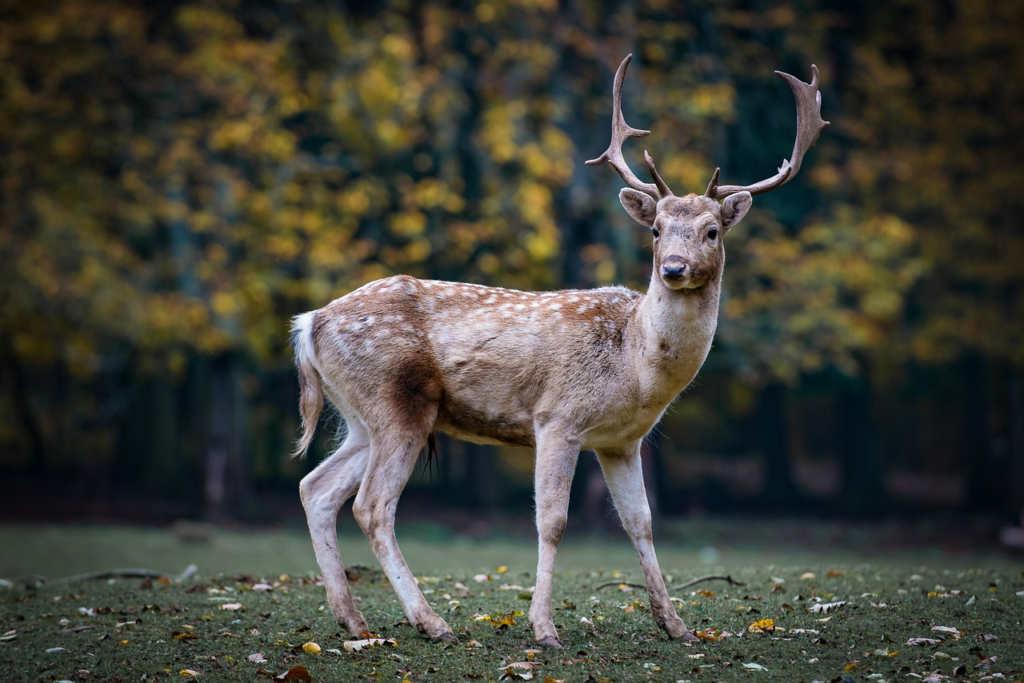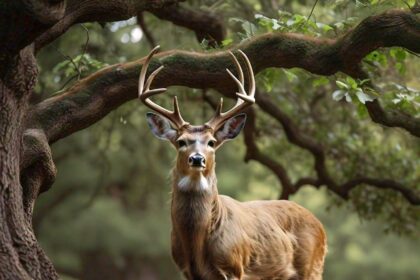Are you looking to hunt deer on public land in Texas? Texas has a lot of hunting lands and spots for deer hunting. But, finding the best places can be tricky. This guide will help you find your way to a successful hunt.

A deer emerges from the dense undergrowth of a sun-dappled Texas public hunting land, its alert gaze scanning the area. In the middle ground, a hunter in camouflage crouches, bow drawn, poised to take the perfect shot. The background features a panoramic vista of rolling hills, scattered oak trees, and a hazy blue sky, evoking the rugged beauty of the Lone Star State. Soft, warm lighting illuminates the scene, creating a sense of tranquility and anticipation. The overall mood is one of quiet focus and the thrill of the hunt, capturing the essence of deer hunting on Texas public lands.
Hunting deer on public land in Texas is an adventure that’s also affordable. This article will show you how to find Texas hunting lands. You’ll learn about permits and the best spots for deer hunting. It will help you turn challenges into chances for success.
Key Takeaways
- Texas public hunting opportunities include over 750,000 acres managed by Texas Parks and Wildlife.
- Annual permits grant access to areas like wildlife management areas and state forests.
- Deer hunting spots on public land often see less pressure than private properties.
- Season timing and regulatory compliance are critical for legal and successful hunts.
- Strategic scouting and permit research maximize your chances of finding active deer trails.
Understanding Texas Public Hunting Lands and Access

A vast expanse of rugged, sun-dappled terrain, the Texas public hunting lands stretch out before the viewer. In the foreground, a weathered game trail winds through tall grass and shrubs, inviting the explorer to venture deeper. The midground reveals rolling hills and dense thickets, casting dramatic shadows under a warm, golden-hour sky. Towering oak and mesquite trees dot the background, their branches reaching skyward, creating a natural cathedral-like atmosphere. The scene conveys a sense of adventure and the promise of abundant wildlife, drawing the viewer into the heart of this untamed, public hunting haven.
To start hunting in Texas, you need to know the rules and options. This guide explains the lands, permits, and regulations. It helps you plan your hunt.
Types of Public Lands Available to Hunters
Wildlife Management Areas (WMAs in Texas) are great for deer hunting. They have managed habitats. National Forests in Texas offer vast areas with different terrains.
U.S. Army Corps of Engineers reservoirs are also available. Each place has its own features. Look at maps to find the best spot for you.
Annual Public Hunting Permit Explained
All hunters must buy the Annual Public Hunting Permit. The cost depends on if you’re a resident or not. It covers most Texas public hunting lands.
You can buy it online or at license vendors. Some WMAs need extra draws or tags. Make sure to check these before you hunt.
Navigating Hunting Seasons and Regulations
There are strict seasons for whitetail and mule deer hunting. You must use weapons allowed by state law. And, you must fill your tags right away.
Bag limits and closure dates vary by area. Always check the Texas Parks and Wildlife website for the latest rules. This ensures you follow the regulations.
Public Land Deer Hunting in Texas Finding Your Spot

A sun-dappled forest in Texas, with towering oaks and dense undergrowth. In the foreground, a hiker scans the terrain, binoculars in hand, searching for signs of deer. The middle ground reveals a well-worn game trail, winding through the lush vegetation. In the distance, a clearing opens up, hinting at the promise of a deer hunting spot, with rays of light filtering through the canopy. The atmosphere is one of tranquility and anticipation, inviting the viewer to explore the hidden treasures of the Texas public lands.
Successful finding deer hunting spots starts with using technology and fieldwork. Satellite maps like Google Earth help spot food, water, and cover. Apps like OnX Hunt show terrain features where deer move.
These tools help find key spots between thickets and open fields. This is where you should set up your stand.
Whenscouting public land for deer, go out early or late to avoid scaring them. Look for signs like rubs, tracks, and trails near water or oak motts. In East Texas, deer like thick undergrowth and fields near farms.
In the Trans-Pecos area, find water sources since deer travel far there.
Thebest WMAs for deer huntinginclude Matagorda Island WMA for coastal thickets and Kerr WMA for timber. WMAs with different habitats, like mesquite flats and cedar breaks, keep deer longer.
Plan your hunt based on hunting pressure. Deer move to open areas early but hide in rugged spots as hunting gets busier. Be ethical by not baiting and respecting property lines.
Using these Texas public land hunting strategies and being patient will help you succeed. Start early, scout well, and adjust to the land’s patterns.
Conclusion: Making the Most of Your Texas Public Land Hunt
Successful deer hunting on Texas public lands begins with good planning. It’s important to study maps, know the hunting seasons, and get the right permits. These steps help you plan better and avoid common mistakes.
Choose the right gear for public land hunting. Opt for lightweight, easy-to-carry items like collapsible stands and scent-control clothes. Being able to move quickly and adjust easily is key in crowded areas. Look for brands like Hunter’s Specialties or Mathews for gear that’s both compact and effective.
Respecting the land is key to ethical hunting. Always take your trash with you, mark your path carefully, and be friendly to other hunters. By doing this, we ensure that future generations can enjoy hunting too. Ethical hunting builds a strong community and keeps hunting accessible for all.
Every hunting trip is a chance to learn and grow. Use the tips shared here, stay up-to-date on hunting laws, and be ready for the challenge. Texas’s public lands are waiting for you. Get ready to test your skills and help preserve the tradition of hunting.







